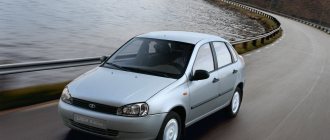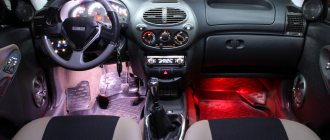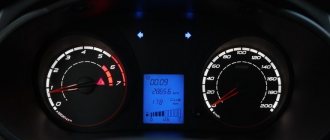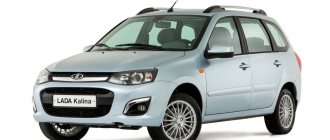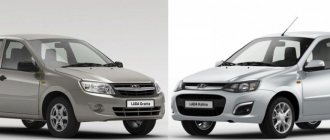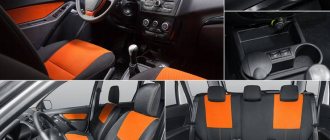The kit includes:
Body kit for VAZ 2194 “Kalina Cross”
- front bumper center cover
- rear bumper center cover
- front bumper cover right
- front bumper cover left
- rear bumper cover, right side
- rear bumper cover, left side
- right sill fairing
- left threshold
- front right wheel arch trim
- front left wheel arch trim
- rear wheel arch trim, right
- rear left wheel arch trim
- front right door molding
- front left door molding
- rear right door molding
- rear left door molding
The appearance of the VAZ-21946 station wagon (this) immediately makes it clear: it is created not only for driving on asphalt. It’s a long way from a full-fledged all-terrain vehicle, but it should wipe the nose of its passenger cars! So why not compare it with the regular VAZ-2194 station wagon?
LADA > Kalina
ASPHALT
Already on the highway, the Cross can pleasantly surprise those who have had the opportunity to drive a front-wheel drive Lada. The source of joy is the pendant! Dense, energy-intensive, but not wobbly. And most importantly, there is no traditional noise when passing small bumps and other sounds characteristic of the front-wheel drive VAZ chassis. Gas-filled struts with upgraded rebound dampers, reduced internal friction and original valve settings do the trick.
The creaking of the upholstery does not irritate either. Of course, the noise has not gone away: winter tires itch, the engine rumbles, the gearbox groans. The transmission noise is not very annoying, but now it stands out clearly against the generally quiet background.
The regular station wagon is the exact opposite. Transmission noise is minimal, thanks in large part to the Jatco automatic transmission. But the suspension is chatty, like in the good old days of all front-wheel drive VAZs. It is also quite dense, but still softer than that of the “Cross”. There is a slight hull sway from bow to stern over bumps that we didn't notice on the Crest. And the interior is distressed by an inexplicable noise in the rear door area, although the car is new. Inconsistent build quality?
At the Dmitrov testing ground, we imitated typical roads of the Russian outback: there was a lot of compacted snow and bare ice. The eight-valve Kalina Cross in the “Norma” configuration and with a manual transmission is aimed at those who do not need electronic assistants. Of these advantages, the only one is the anti-lock brake system.
I liked the performance of ABS on icy surfaces in general and in particular. Imagine a long descent. One of the most unpleasant situations for a front-wheel drive car under these conditions is the steering wheel locking (they are also steering wheels) and the engine stopping (the gearbox is engaged!). On a Cross with ABS, it is not at all necessary to carefully measure the force on the brake pedal: press it and that’s it, the car will not turn into an uncontrollable bullet. Otherwise, the Cross offers freedom throughout the entire speed range. Those who know how to do this can also ride the slides, as the Cross is well controlled.
The engine, which at the moment is not the most structurally advanced, allows you to drive under pressure, avoiding skidding. For example, on a slippery slope of six percent, you can move the car from one place, immediately switch to second gear and crawl almost to idle. The main thing is not to press on the gas so that the wheels do not tear from skidding.
But Kalina with a 16-valve engine and an automatic transmission, in this case, has an electronic stabilization system combined with traction control - this is the prerogative of cars in the maximum “Lux” configuration (more modest versions have only ABS). There is no need for gentle throttling here. Move to Drive - and press the accelerator pedal. The electronics will do everything itself, and the car crawls uphill without slipping. But this will not let you enjoy the high-speed slides. ESP can be switched off, but at a speed of 50 km/h it will automatically turn on again. Therefore, when accelerating intensively with ESP turned off, do not forget that the electronics, awakened at a speed of 50 km/h, can abruptly stop traction on the wheels.
Country trails and virgin snow should lead the “Cross”. It is taller and better protected from below. These conditions require a manual transmission, 3.9 main torque and an engine with acceptable low-end pulling power. You can move on loose snow even with almost full throttle. Where there is more snow, you accelerate a little and scratch further with a slight slip - the Cross confidently crawls forward.
Stuck? It's easy to fall back to the old rocking method. Small twigs, twigs, and hard crusts are not scary: the black plastic body kit protects the sills and bumpers well from scratches. The tight suspension instills confidence that the car will not bite or run into an obstacle at the most inopportune moment.
Useful tips
When upgrading or creating a new body kit for viburnum, you should adhere to the following recommendations:
- Before tuning, find out what modifications are permitted by traffic rules.
- You can find standard tuned body kits for your car. They are somewhat more expensive than standard parts, but have an unusual appearance.
- When purchasing, it is recommended to purchase the mesh separately. It will be a good addition to the body kit.
After alterations and modernization, all changes made to the design of the car must be registered with the traffic police.
After tuning the bumpers, the car has a very interesting appearance. Upgraded parts can be purchased either ready-made or created independently.
NOT EXPENSIVE AT ALL
At the end of January, when we conducted this test, the nearest station wagon with a manual transmission and the same engine cost 427,800 rubles. And for the Cross, dealers asked 451 thousand rubles. The difference is about 23 thousand. Great offer! After all, the “Cross” is a large alloy wheel, an off-road body kit, increased ground clearance, a modified suspension, a short main torque in the transmission and a more pleasant interior. He promised the imminent appearance of a Cross with a 16-valve engine, more powerful - another 10 thousand more expensive. This is also tempting.
Against this background, the price of the test "Kalina" car seems inadequate - 523,800 rubles. But “automatic”! And the “Lux” equipment comes with a stabilization system. Look through the price lists - foreign cars of this class with automatic transmission, air conditioning and other advantages are much more expensive.
And now - get out of the farm! Three days behind the wheel of the new Kalina - and even the author over forty gives preference to the young model. I mean "Cross". Increased underbody capacity, non-standard appearance, reasonable suspension. I'm finally going!
it’s just that the Kalina station wagon seemed somehow pensioner-like, despite the 16-valve engine. And something tells us: buyers will look for silence, coziness and comfort in cars from other automakers.
The editors express gratitude to MPO Tekhinkom and AutoHERMES-West for the equipment provided.
I decided to talk about my equally interesting improvements. It’s worth starting with the fact that I really like the Kalina Cross - this is a very successful device from VAZ, which suits all categories of people, which cannot be said about the first generation Kalina, but the situation was such that I had to buy a used first generation Kalina instead of a new car.
To be honest, I didn’t regret it, I skated for the first six months and did practically nothing until I signed up for D2. Having gained experience, knowledge and advice, I decided to remake the car. The modifications were to consist of two parts: external modifications and technical modifications.
It was decided to change the car to Kalina Cross suspension. Thus began the stage of purchasing materials, which lasted three months.
As a result, it was replaced: — Front struts 21928-2905002 / 003-50 SAAZ. — Supports contributions from Anvis. — Springs 21928 class “A” (barrel). — A series of shims for Anvis and new bearings. — Amplifier windows of the front pillars. — Stabilizer 21900-2906010-00.
— Rear shock absorbers 21928-2915004-50 SAAZ — Rear springs 21928 Class “B.” — Upper spring cushion. — Increased travel buffers.
— Wheels K&K Kalina Sport 14 ”5'5 J 35 ET. — Kama tires - 236 euros 185/65 / R14.
Catalogs: 21928-2905402-50 — Front right shock absorber for LADA Kalina Cross 21928-2905403-50 — Front left shock absorber for LADA Kalina Cross 21928-2915402-50 — Rear suspension shock absorber for LADA Kalina Cross
21928-2902712-00 — Front spring 21928 (variable pitch) 21928-2912712-00 — Spring 21928 “Kalina 2” rear.
21900-2902821-00 — Front strut support 2190 21900-2902821-10 — Front strut support assembly for vehicles with electric power steering
At this point the technical stage is over, or maybe not - some ideas come from time to time))
Now about the visual transformations. Please note that most modifications are made only using factory components (including stickers on door jambs).
The first thing I did was add roof rails to the car, with them the car is a little more brutal.
After covering the bumper.
Next comes the installation of moldings. 21900-8212141-00 — Molding of the front left door 2190. 21900-8212140-00 — Molding of the front right door 2190. 21900-8212151-00 — Molding of the rear left door 2190. 21900-8212150-00 — Molding of the rear right door 2190.
At the last moment, blackening the door pillars and replacing the “colored” saber with a black one. Two rear ones specifically for the station wagon 11170-8212329-00 — Molding of the rear door pillar, rear left 11170-8212328-00 — Trim of the rear door pillar, right Single covering for Kalina of all bodies and versions. 11180-8212325-00 — Trim for the front left rear door pillar 11180-8212324-00 — Trim for the rear right front door pillar 11180-8212323-00 — Trim for the rear pillar of the front door, left 11180-8212322-00 — Trim for the rear pillar of the front door, right 11180-8212327-00 — Trim of the front left rear door pillar 11180-8212326-00 — Trim of the front right rear door pillar Rear trim for sedan and sedan (if anyone needs it) 11180-8212328-00 — Trim of the right rear door pillar 11180-8212329- 00 — Rear door pillar molding, rear left
11180-8212526-00 — Trunk hood trim (Sabre) Now I’m waiting for the unpainted rear window trim (triangles). 11180-6203451-01 — Left door trim 11180-6203450-01 — Right door trim
After all the installations the car looked like this:
Everything is clear from the visual changes, but what did installing a new suspension give?
Firstly, this is a factory elevator. In numbers, the measures are as follows: Front sill - 220 mm Rear sill - 242 mm Front eye - 250 mm Rear eye - 360 mm Protected - 197 mm Without protection - 211 mm With factory boot - 206 mm
Kalina Cross stated that the ground clearance of the empty car is 208 mm. If I understand correctly, we are talking about moving away from the bottom point without protection. My protection is 3 mm, and the distance from the protection to the lower elements of the car is about 10 mm. As a result, adding up all the indicators, we get the declared authorization of Kalina Cross. And this is not the most important thing!
The first feeling is smooth pedaling (stroke) with a fairly stiff (or, so to speak, dense, springy) suspension. This is somewhat strange for me.. I, like my passengers, don’t feel the “Zubodrilka”. The suspension eliminates unevenness so well that the car does not have time to sway, and accidental impacts on the body are minimal. That is why the smooth ride is declared - the suspension seems to “keep” the body in maximum condition parallel to the road. For example, I chose the road I drive on every day. The average speed of the flow along it is 20-30 km/h, it is no longer comfortable, it is very broken. I went the same way. Although, if you look closely, the holes are not very deep, maximum 5-6 cm, there are a lot of them. On the good side, these holes probably cannot be called shallow, but, given the general realities, yes, they are shallow.
During the first few days of riding the Cross, I began to notice that I could go faster. I don’t want to, but I can without losing comfort. For a week I tried to drive at a speed of 50-60 km/h and I succeeded. I can’t say that I flew over it, it’s still a suspension, not an air cushion, and it’s clear that it’s unrealistic to cope with all the irregularities. Of course, there were blows to the body, but this is not so critical. The car, to the envy of the round alley, covers this road much faster. I'm not considering a car with huge wheels and a multi-link.
Now regarding the road junctions on the highway. They are always and everywhere. Passing such seams 2-3 cm wide and deep used to be inconvenient. Quite hard bumps, clanging of the upper washer and other manifestations of a tired original suspension. Now the car passes such joints without a single hint of swaying, and from the sounds I only hear the slap of rubber on the asphalt and feel a slight vibration.
There is also a dirt road. This is where the element of the Cross is! On smooth gravel or dirt roads, you can press the pedal and not worry about small bumps or rocks. Even large bumps will do. I really liked it...
The high-riding driving experience is a mixed bag and not for everyone, but I like it. But the driving experience with a ground clearance of 20 cm is unparalleled. Often I have to drive through a village under construction, where the roads are only dirt, and due to the continuity of our terrain, after every rain they become stones with the relief of a fortified anti-tank zone. So going through these holes is a pleasure. You look at people walking through gardens or bushes and smile: here’s a car, then a car.
Geometric cross-country ability is like that of a good crossover. Jumping off highways into ditches, driving over curbs or negotiating a field road with meltwater gullies is not difficult. Within reasonable limits, of course. When I tested these qualities, I always paid attention to the well-worn path and took it a little steeper, somewhere right through the ravine.
To evaluate the performance of the plug, he specifically allocated about an hour of travel time on bad roads and checked how the car now maneuvers. I was not driving on purpose, but for the purpose of checking, so I focused all my attention on the car. The speed was around 60 so some of the pitfalls were quite sharp. I was pleased with the result. The maneuver is safer, the car holds the road stronger, and there are much fewer blocks on turns.
As for the route. On flat areas the car rides as if on rails. The speed of 110 seems to be insufficient, the leg stretches again to give the gas. Long turns take place without much roll, and the steering wheel is no longer soft, it has become more informative and tends to coincide with the same long turns. I don’t know who and how, but I liked this responsiveness.
By the way, after the work done, I began to like the brakes. I don’t know what happened, but the car brakes perfectly, doesn’t stop nodding, but this makes it much more pleasant. It was just as nice.
What to tune and what material to use?
It is worth understanding that tuning must be comprehensive, because if you install, for example, a sports bumper, while forgetting about the thresholds, then the sedan or hatchback will look ugly and disproportionate. This must be avoided by any means possible. Therefore, before going to the workshop, try to imagine how the body kits will look individually and together.
After this, you can decide which part you are going to modernize and which part you are going to leave as is. Of course, for this you need to have imagination, but you can just look at photos of tuned cars on the Internet. There you can find the Lada Kalina of any colors and with any body kits, because tuning it is a fairly popular activity.
But it is always important to understand that body kits look especially harmonious when they are connected to each other. A beautiful combination that will highlight the appearance of any car: sills, rear and front bumpers.
Kalina Sport with this “outfit” looks especially attractive, because the installed parts emphasize its sporting characteristics, power and speed. And if you ensure that the body kits of the Lada Kalina increase the aerodynamics of the car, then such tuning of the appearance will be the most suitable.
Of course, the modern automotive industry offers many options for materials from which body kits are made, but the most commonly used are fiberglass or ABS plastic. These materials have been used for a long time, so all their pros and cons have been identified in practice. It is worth dwelling on each of them separately.
- ABS plastic. A modern, fairly cheap type of plastic, which is distinguished by its flexibility. Body kits made from it are resistant to impacts, as well as to various aggressive environments. ABS plastic does not deteriorate under the influence of gasoline, does not deteriorate due to temperature, and also has excellent adhesion to paint and varnish coatings and primers. All this makes it very versatile, but it is worth noting that at low temperatures it becomes very fragile. And if you take into account the fact that it is from ABS that the lowering body kits for the Lada Kalina hatchback are made, then you can understand that you need to drive a car if such bumpers are installed on it, you need to be careful. Otherwise, there is a high probability that the cladding will burst from a light impact on a curb or speed bump.
- Fiberglass. The material, which is an analogue of ABS, is devoid of its disadvantages. It can be used in the harshest environments and is durable enough for everyday tasks. Of course, fiberglass will not withstand a serious accident, because its flexibility is not enough to remain intact after an accident. But accidents with a Lada Kalina car rarely happen, because it handles well. The only disadvantage of fiberglass will be the difficulty of painting it. Primers and paints do not adhere well to it, so painting work should be done by professionals.
Kalina bumper trim
It serves not so much as protection, but rather to give the appearance of the car new characteristic features. There are a lot of such elements. And you can choose the one you like the most.
Overlays
| Name | Properties and Functions | Peculiarities |
| For example, the Courage overlay | Creates a more aggressive and expressive appearance, the front part is lowered by 2 cm. The trim is fixed on the bumper and looks like a single unit with it, creating a sporty style of the usual Kalina modification. The use of this pad improves aerodynamic performance due to the protrusions at the front and sides. | For fastening, you can use a special sealant or ordinary self-tapping screws. |
| Overlay Cameo-Sport | It also affects aerodynamics, increasing downforce, which is important when driving at high speeds. The design of this element improves the vehicle's handling and increases steering sensitivity. The design features of the lining make it possible to redirect oncoming air flows, thereby reducing resistance. | For installation, you can use two methods: either with plastic sealant or with bolts. In the first case, speed is attractive, and in the second, reliability, although installation with bolts will take much more time. |
| Runi pad | Chrome plated. Gives the car solidity. made of high quality stainless steel. | The rear bumper option complements the existing body kit. |
Another one is Totti's rubber. Like all others, it was created to decorate Kalina and improve aerodynamic properties. In addition, it provides protection against dirt and creates a unique style of appearance. This series of pads is characterized by durable material that ensures reliability and durability.
